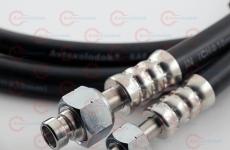Firmware htc desire a8181 from a flash drive. Best firmware for HTC Desire with Sense shell - Runnymede and RuHD
Having bought a not cheap device, you always want to squeeze the maximum out of it, because it was not just bought for calls, especially when it comes to HTC, there are more alternative firmware for these smartphones than for everyone else.
MIUI 2.4.6 and 2.3.7(Android 2.3 custom UI)
This firmware is different from all the others, after using it, I switch screens out of habit instead of entering the application menu. The firmware is made 1 in 1 for the IOS interface, all applications are located on the desktops, if you remove the shortcut from the desktop, it is removed from the phone, to save space, you can create folders on desktops and drop shortcuts into folders.
- The taskbar has switches for wifi, bluetooth, screen auto-rotation, data transfer, etc. very convenient, no need to go into settings to switch basic functions
- There is immediately root
- The unlock screen has player controls, you can turn on the flashlight by holding the HOME button, you can immediately see missed calls and unread messages, you can go directly to the phone or messages
- There is a built-in firewall for blacklisting numbers, etc., but it works a little crookedly
- Battery life is noticeably longer, but many standard services have been cut out, because of this some specific applications do not work correctly
- There is a delay in response, i.e. you pick up the phone, say ale ale, and only after 2-3 seconds will you be heard, i.e. Microphone does not turn on immediately
- There is a standard means of recording conversations, but only the interlocutor is heard in it, nothing is heard from the microphone, i.e. there is no point to it.
- In some applications, for example, in QIP, there are glitches with the display of the interface, the buttons are spreading, etc.
RUHD 3.0.1 (Android 2.3 and Sense 3.5)
 Here we have almost stock firmware, but with many useful things, and also Sense 3.5 and updated applications. When you first start the firmware, we are asked which programs to install and which are not needed, many unnecessary applications have been cut out. But the firmware is a little heavy for the device.
Here we have almost stock firmware, but with many useful things, and also Sense 3.5 and updated applications. When you first start the firmware, we are asked which programs to install and which are not needed, many unnecessary applications have been cut out. But the firmware is a little heavy for the device.
- There is a built-in processor frequency control tool, you can make the frequency higher than the nominal one, or vice versa, you can lower it to save battery, you can assign processor frequency profiles depending on the battery charge, for example, if 10% is left, then it is logical to reduce the frequency to 128 MHz, endure dullness, but but stay connected.
- In the phone shutdown menu there are additional items silent mode, vibration mode, airplane mode, turning off mobile Internet
- From the lock screen, you can directly open Phone, Mail, Camera, Messages
- There is almost no delay in response (about half a second)
- The camera is working fine
- The interface is responsive, but slightly inferior in speed even to the standard one, let alone MIUI, Sense 3.5 is heavy, eats a lot of RAM
- The taskbar has switches almost like in MIUI
- There is standard means to block ads, use windows network resources and much more.
Nikez Lente 1.0.1a6 (Android 4 and Standard UI)

The firmware is at the beta stage, I installed it for the sake of interest, at the moment all custom firmware on Android 4 does not work quite correctly
- There is a significant delay in the response, just like not MIUI
- The interface is a little blunt, this is due to the curved 2d acceleration, but they say a new custom kernel will be released soon and the situation will improve
- From the shutdown screen, you can go directly to BootLoader or Recovery
- There are no switches in the taskbar like on MIUI and RUHD
- Naturally, the interface of the fourth android is very interesting and convenient
Yes, a little off topic, but still the other day I flashed my own, already quite old, smarfon and I have experience. As they say, the same firmware is something in common with satellite receivers.
I hope with this post I will help someone and reduce the time spent, as there is a lot of information, but for the most part it is very scattered. Next by myself htc desire a8181 flashing process on android version 4 or higher.
To start. Many people write that you need to unlock the bootloader - I did not succeed, nor the program HTC Bootloader Unlock, nor the standard method through the office. htc site.
Instructions for htc desire phone firmware on android 4 +
As it turned out, I had the last official update with android version 2.3. Accordingly, S-ON is software change protection. Which needs to be removed first.
But before you do anything, you need to install your device drivers on your computer twice.
You need to do this in semi-automatic mode, each time pointing to the folder with the drivers.
First HTC Drivers needed with a normally working phone, and the second Android USB Driver- when working with the bootloader and in recovery mode.
According to instructions. Personally, I uploaded the archives to the root of the C drive and installed it from there, or rather indicated where they were.

So the drivers are installed and the phone is visible in the computer - we move on.

As already mentioned, you need to remove S-ON to make S-OFF. You can see the status like this. Turn off the phone - remove the battery and press the volume down + turn on.

Visible at the very top.
How to remove S-OFF htc?
Exactly how I did it. We go to the site http://rev.alpharev.nl/ - download the application for windows in the same place. Fill in the data here. We take the serial number in our phone - we look in the settings or look under the battery.

We enter keeping the register. We generate and receive the code that we enter in the running application from there. The phone must be connected by cable.
After that, you should get S-OFF and the inscription in pink.

The next step is to sew a recovery to an alternative one. We need an archive Android- which we unzip to the root of drive C.
There is Recovery Flash.bat and recovery.img (recovery-clockwork-touch-5.8.0.2-bravo.img). When you start the first one, the second one should be flashed. I chose this particular version of the recovery, because it seemed convenient to me, it worked adequately and the control was familiar - with a finger. You can look for an alternative and just rename it to recovery.img and sew the same way.
Next, you need to get the rights of the super user. My program worked KingoROOT from under Windows with a normally turned on phone through a cable.
All this allowed me to flash the phone to custom firmware. Of course, the first one that came across did not suit me, and the second one was also poorly installed. In short, I settled on this CM10.1_VJ_4.2.2_V6.2_Sense_Data++.zip . With an increase in space for programs on an external flash drive.
Do not think that everything is only in the firmware - that is, installing software. It still needs to be configured. So it's almost a bare system.
The instructions at the address helped me a lot.
http://4pda.ru/forum/index.php?showtopic=366523&st=7220#entry39335246
But don't trust her completely. See for yourself what you need more.
I did not delete Google services and updates - I just turned it off and this immediately gave a lot of space for the necessary programs.
I found it necessary to install LowSoundFixer_v1.0.8.apk(increases volume - firmware bug) and SD+Maid+Pro+v3.1.4.6_arm-zipalign(cleans the cache and garbage on the phone). And the rest is not.
pic phone screen
Conclusion - the phone works fine and is configured for modern android. Now you can install the necessary applications that did not work on old version, besides a lot of space for games and programs. Definitely need to sew.
Video firmware htc desire a8181 android 4
Many users specifically install firmware without a proprietary shell - Sense - on their HTC smartphones in order to free up more memory, get rid of brakes, install other launchers. But there are those who like HTC Sense and they can be understood, because the shell from HTC is rightfully considered the best interface from the manufacturer Android devices. In this post, we will look at the best way to get custom firmware on your HTC Desire from the very latest version HTC Sense, which is used on the top HTC Sensation series smartphones (Original, XL, XE) - Runnymede and RuHD.
Runnymede AIO Firmware

It is the most popular custom firmware with Sense shell for HTC Desire. Thanks to the huge community on xda and programmers with direct hands, the firmware really boggles the mind with the beauty of Sense 3.5 and the speed of work.
Peculiarities Runnymede for Desire:
- The firmware is based on the official HTC Sensation XL firmware 1.22.461.2 : Android 2.3.5 with shell HTC Sense 3.5
- Full version of Sense 3.5 including everything 3D widgets and effects.
- RCMix3D Tweaks: special settings menu for lockscreen, statusbar, processor and system tweaks and many other system settings.
- Built-in App2SD to transfer any application to the card
- Deodexed & zip aligned
- init.d support
- Complete system optimization for best performance with all Sense 3.5 effects
- Multilingual
- The ability to configure unlocking and wakeups by pressing the trackpad.
- Superuser 3.0.7
- Ability to fine-tune the power and frequency of the processor (Daemon controller, IncrediControl)
- Graphic touch installer
- Beat Audio
Video presentation of the firmware Runnymede for HTC Desire
Requirements Runnymede for HTC Desire

Installation Runnymede for HTC Desire
- Make sure that your Desire meets all the requirements described above, they are all required for the correct operation of Runnymede (partition table, s-off, ext partition), if you are installing custom firmware for the first time and are not confident in your abilities, you .
- Runnymede-
- Install .zip from SD card in recovery)
- The graphical installer will load, follow the instructions on the screen
RuHD Firmware
The RuHD firmware for HTC Desire is essentially a domestic modification or version of Runnymede, some goodies have been added, something has been removed, tweaks and scripts from domestic craftsmen have been added.
RuHD Features for Desire: 
- Android 2.3.5 and HTC Sense 3.5
- Beat bass & Cloud
- Works in WiFi networks N
- Integration with HTCSense.com
- All languages except English and Russian have been removed, Russian translation has been improved wherever possible.
- Installation completely in / system (free memory - 15mb), does not require ext partition
- The firmware includes su, busybox, terminfo, passwd and group
- hosts are set to clipping ads (no need to install third-party applications AdFree, etc.)
- APP2SD+- the ability to transfer applications to a memory card (need ext partition!)
- Optimized boot, sqlite defrag at startup, zipallign
- Availability of processor profiles
- Support OTA updates and installing firmware additions of one branch
- Additional RuHD settings menu - system tweaks, processor controls, advanced interface settings (similar to the RCMix3D Tweaks menu in Runnymede)
RuHD Requirements for Desire:
- Desirable, but required: S-OFF, ext-partition on the map
- The latest version of the radio module (available on the firmware website, you can flash it after installing the firmware)
 Installing RuHD for Desire:
Installing RuHD for Desire:
- Make sure that your Desire meets all the requirements described above, all of them are required for the correct operation of RuHD, if you are installing custom firmware for the first time and are not confident in your abilities, you.
- Back up your data (for example with )
- If you are switching from another firmware, then before starting you need to do a full wipe! (full wipe - data\factory reset in recovery)
- If you want to update the version RuHD- clean cache and dalvik cache, / system and / boot through recovery
- Download the firmware from the links above, put the zip archive in the root of the card and flash from the recovery ( Install .zip from SD card in recovery)
- Follow the instructions on the screen
Conclusion
Both firmwares are very high quality and stable, great for everyday use. The main and perhaps the only drawback of both firmwares is excessive power consumption, but this, of course, is the price for all the Sense 3.5 chips, compared to other custom firmware for Desire without Sense (for example), the batteries last 10-15% less. But on the other hand, the speed of both firmwares is on top, the developers really managed to achieve almost perfect smoothness and speed of work.

Best firmware for HTC Desire with Sense shell - Runnymede and RuHD:
rating 80 out of 80 based on 80 ratings.
There are 80 reviews in total.
I am a happy owner of HTC Desire A8181. When I bought it a year ago, my joy knew no bounds. Came out after a while samsung galaxy S, HTC Desire HD, HTC Incredible S, etc. and then one fine day the era of "monsters" began on 2 cores with powerful graphic coprocessors (I think it makes no sense to list models)
I realized that I had a phone in my hands, which I bought “gray” for almost $ 700, but then it was a “monster”, now it is hardly relevant against the backdrop of fresh interfaces and high performance. Since the warranty came to an end, I decided not to waste time and squeeze out everything that was possible from my "desire". First of all, I got the rights ROOT, then S-OFF. I explain:

ROOT- in other words, “granting super-user rights”, they allow you to feel freer in managing your phone, working with applications, almost all of them (with ROOT rights) are placed on the memory card; the ability to create Ext (the system will see the allocated space on the memory card as part of the phone’s memory) and Swap (a partition that works as a “paging file”, as it creates additional RAM) partitions.
S-OFF- Security OFF - turn off the protection of the phone to "expand the possibilities" of working with it.
Then I flashed the latest version of the radio module (responsible for the signal quality in the GSM / CDMA network, the stability of Wi-Fi). Then there was the question (the most interesting) of installing custom (modified / ported from another device, more colorful / productive) firmware.
In this article I will talk about 4 firmwares that on my HTC Desire proved to be the brightest and differed from other firmwares in a number of "features", "usefulness" and "goodies". Let's get started.
In order not to clutter up the blog with huge screenshots, you can view them slightly reduced in flash. Screens "in full growth" !
MIUI. (Now relevant, personally for me.FCR_MIUI_R29.3, but there are many modifications of this firmware)

The appearance of the firmware is beautifully "licked" from the iphone. There is no NTS Sense in the firmware. The settings menu looks the same as in iphone. The ability to customize themes, the background of not only the desktop, but also the lock screen. The ability to jump directly to the phone (dialer) / sms / just unlock the screen on the lock screen (by the way, this function was used in MIUI earlier than in Sense from NTS), there is a scroll bar at the bottom of the desktop - under it is a block of dedicated programs that you can fill yourself / edit
Performance. The firmware does not slow down in any way, does not freeze. Based on the test results in Quadrant, NeoCore, Benchmark AnTuTu, we can conclude that MIUI is a very productive and fast firmware!
Personal opinion: the firmware is original, brightly different from others, has a peculiar look, has high performance and its own branded add-ons. Those who have nothing against the iphone and its interface - I advise you to take a closer look!
Oxygen. (I have tested oxygen-2.1.4)
 Before us is what is called "naked" Android. There is no HTC Sense interface (a sacrifice towards performance). The firmware looks insufficient - everything was pulled out of it - and NTS Sense, and all the built-in programs, and even the set of widgets is limited. But this is the whole point of Oxygen - this is the firmware that the user "cuts" on his own, while installing only those applications and widgets that he needs.
Before us is what is called "naked" Android. There is no HTC Sense interface (a sacrifice towards performance). The firmware looks insufficient - everything was pulled out of it - and NTS Sense, and all the built-in programs, and even the set of widgets is limited. But this is the whole point of Oxygen - this is the firmware that the user "cuts" on his own, while installing only those applications and widgets that he needs.
It is also possible to install additional those, using which the device changes before our eyes (I used Oceanis_oxygenv2-6). There is a specialized menu from Oxygen in which you can make serious settings regarding the phone.
Performance. The firmware has proven itself well, really fast, which is why it is popular.
Personal opinion: the ability to adjust the device for yourself, everything that could slow down the capabilities of the device is cut out. This is one of the most productive "naked" Androids. Suitable for all those who are chasing performance, who are looking for the most customizable version of the firmware. But in my case, some glitches of the system occurred, then the lower bar of programs disappeared into nowhere, then the phone itself rebooted, in general, it was a little unstable.
Cyanogen Mod 7.
 Before us, again, is “bare” Android, without the HTC Sense interface. The firmware is notable for the fact that it is updated once a day, CyanogenMod 7 has the concept of “nightie” - nightly (frequent update), the guys from this team upgrade the firmware every day, and when they release a stable version, they upload it separately, they call it stable, which logical
Before us, again, is “bare” Android, without the HTC Sense interface. The firmware is notable for the fact that it is updated once a day, CyanogenMod 7 has the concept of “nightie” - nightly (frequent update), the guys from this team upgrade the firmware every day, and when they release a stable version, they upload it separately, they call it stable, which logical
The firmware is also quite productive and very “customizable”, and to the maximum, you even need to install applications from google separately. Fairly fast and stable, unlike Oxygen (perhaps this is only in my case).
Performance. The firmware behaves well both in simple situations and at times of special load. It performed well in tests.
Personal opinion: great alternative to oxygen, frequently updated, stable, fast. Suitable for all speed seekers. In my case, the sound of the conversational speaker went down
RCMixS. (used version RCMixS_v2.1_A2SD_CM7Hboot_TEST4).

This is the brightest and juiciest firmware that I have ever installed. NTS Sense 2.1 + 3.0 is involved here. The firmware is “live”, mega-beautiful, but can not boast of performance in any way, unlike the firmware listed above. Everything is compensated by beauty.
Performance. The performance is at a low level, but not lower than on the "native" firmware for HTC Desire. In everyday use of the device, slowness is not felt - poor results are visible only in tests, but not in practice.
Personal opinion. This firmware is just a dream for those who are looking for themselves in firmware with Sense. In it, Sense is not buggy and does not crash, animated wallpapers, weather and active icons on the lock screen - everything works fabulously. NTS Sense 2.1+3.0 only here and only now! It feels like your Desire turns into Sensation, or at least into Incredible S. I still can't get used to it myself.
My verdict
- 1. The most original - MIUI
- 2. The most productive (fast) - MIUI / Oxygen / CyanogenMod 7 (to each his own)
- 3. The most beautiful - RCMixS
Of course, there are still a huge number of firmware for HTC Desire, and all of them are interesting in their own way. In some more interesting interface, in another - the camera behaves better and shoots HD video, thirdly, something else is possible. Everyone chooses what he likes more, sets his own priorities. I showed an example on my HTC Desire, but similar firmware (which radically changes the impression about the device) is available for almost every Android smartphone, so I wish you good luck with flashing!
Thank you all for your attention, I hope my work helped someone, it was just interesting for someone, in any case - good luck to everyone!
Recently on site developer.htc.com appeared official firmware for HTC Desire. This upgrade to version Android 2.3 Gingerbread although it is available for download to anyone, it is not available from the update menu in the smartphone itself. This is due to the fact that Desire has a rather small amount of memory and the developers do not recommend updating to 2.3 ordinary users. The updated firmware is missing background images, the Facebook application and some programs HTC Sense.
1. Preparing the smartphone for firmware.
The first thing to do is save contacts to a memory card. To do this, click on the screen "Telephone", go to the address book (where all contacts are displayed) and press the hard button menu. From the menu that appears on the screen, select "Import Export" and choose "Export to SD card" and get the file on a flash drive "pcsc_pcsc_00001.vcf" or another type with extension. vcf file.
We copy all data from the SD card to a computer, just in case, because photos and possibly other necessary files are stored there. We format the SD card to delete all data that is no longer needed on the card. After all, all programs will have to be reinstalled, and they will create directories on the card for themselves. We go "Setting" — "Device Memory" — "Remove memory card" — "Erase SD Card".
Resetting HTC Desire to the initial settings, then all installed applications will naturally disappear, but the phone will immediately free up all possible free space in the memory of the device itself and there will be no problems if free space is required during firmware. Therefore, we go to "Settings", Further "Device Memory" and the lowest point will be "Reset factory settings". After the reset, I got 136 megabytes of free space.
2. Download the firmware.
Well, of course, you need the firmware itself, download it either from our website at this link - or from the official HTC website.
After downloading the archive, we see 4 files:
- Flashlight_signed_07072011.apk- flashlight
- teeter_signed_07072011.apk- ball game
- htc_wallpaper.zip- background images (archived)
- - the firmware itself (in the archive)
Because Android 2.3.3 takes up more space, then the standard programs (a flashlight and a toy with a ball), as well as “wallpapers” were removed by the HTC developers from the firmware and made as separate applications that can be installed if you still need them.
I'll run ahead and say that after resetting to factory settings, the previous android 2.2(official update) on my HTC Desire, freed up 136 megabytes. After flashing to 2.3.3, there were 128 megabytes of free space. I think you will not be afraid of the loss of 8 megabytes of free space, because now almost all applications can move to an SD card.
3. What is needed?
Find and unpack the firmware itself ( HTC Desire Android 2.3 Upgrade.zip). There are 2 files inside PDF instructions and EXE which is a self-extracting installer, after launching which, the firmware and flasher are unpacked into a temporary folder and automatically launched.
Let's see what the instructions recommend. The first point is advised by the characteristics of the PC on which the firmware will be produced. At least a gigahertz processor, 512 MB of memory or more, 150 megabytes of free disk space and USB 2.0. Operating system Windows from XP Home to 7 Ultimate.
4. Connecting and setting up HTC Desire for firmware
Install HTC Sync if you haven't installed it yet. If installed, but not running, then run. Download HTC Sync you can from this site, by reference - or from saya.
We connect your HTC Desire USB cable to the computer, select synchronization on the display. If everything goes well, then HTC Sync on the computer will see the device. I recommend connecting to system unit, since when I connected to the USB hub in the monitor, I got an error during the firmware ( ERROR : USB CONNECTION ERROR), which reports an incorrect connection, or problems with the drivers.
We check that your computer will not fall into sleep mode when idle and after a certain number of minutes. Well, I also advise you to remove the inclusion of the screensaver. Close all unnecessary programs on the computer.
Disable the screen lock. We go to "Settings" — "Safety" — "Change blocking method" or ( "Set up screen lock") — "Unprotect".
We check the battery level (The official instructions recommend not less than 30%). We go "Settings" — "About phone" — "Battery".
We launch the flash driver, the file " RUU_HTC Desire Android 2.3 Upgrade (Gingerbread).exe»
Attention! Do not forget to save all data from your phone (contacts and files from the memory card). Do a factory reset and clean the memory card. And remember that after flashing all your data and settings will be reset.
The flashing time takes about 10 minutes, do not pull out the cable from the phone or computer, do not press the buttons on the phone and it is not recommended to use the computer, wait until the end of the procedure.
5. Update HTC Desire to Android 2.3 Gingerbread (flash driver instructions)
Once again, make sure that you did a factory reset, which led to the removal of all installed applications on your smartphone and factory reset.
In the first window, just click " Next". In the next window, we are again warned that it is necessary to delete all data from the phone and offer to read the ReadME (instruction in English).

In the third window, they remind you to turn off the hibernation mode in windows, the battery level and check the USB cable connection.
 Put a tick and click "Next", after which the connection of the smartphone to the computer and the status of the device are checked.
Put a tick and click "Next", after which the connection of the smartphone to the computer and the status of the device are checked.

After a successful check, in the next window we see the "Update" button.

We click on this button and in the next window we see the firmware version on the device and the version to which your Desire will be flashed, click “Next” again.

And the last window that appears, before the update process, tells us that by pressing the “Next” button, the process of flashing the device will begin, all information will be displayed on the screen, and at the end we will receive a message about the successful update of the device. It's not too late to refuse, but we click "Next" again.

Started! That's what all this was done for, the process of updating your HTC Desire to Android 2.3.3 has begun
It all looks like a small window with a progress bar, a message that the process will take about 10 minutes, in no case do not touch the USB cable connecting the smartphone to the PC.

At the end, we get a window with the “Finish” button and a message in English that the process has been successfully completed.

Hooray! Now your HTC Desire works under Android 2.3.3
We restore contacts and necessary data from backups and reinstall the necessary applications.
Possible error messages:
ERROR : FILE OPEN ERROR- file read error, try to run "RUU_HTC Desire Android 2.3 Upgrade (Gingerbread).exe" again
ERROR : MAIN BATTERY POWER– the battery charge of the smartphone is less than 30%, put it on charge and try again when the battery is sufficiently charged.
ERROR : MODEL ID ERROR
ERROR : CUSTOMER ID ERROR– the firmware is not designed for your smartphone model.
ERROR : IMAGE ERROR- the firmware file is incorrect or damaged, try downloading the firmware again from the site.
ERROR : USB CONNECTION ERROR– USB cable connection error. Connect the cable directly to your computer, not to USB hubs.





